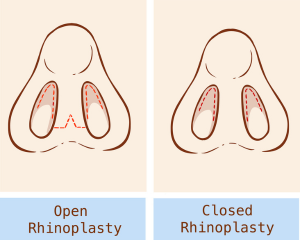
Rhinoplasty, a sought-after cosmetic procedure, allows individuals to enhance the appearance and function of their noses. When considering this transformative surgery, one crucial decision is choosing between open and closed rhinoplasty techniques.
Open rhinoplasty is a surgical technique that involves making a small incision across the columella, the strip of skin between the nostrils. This approach provides unparalleled visibility for the surgeon, allowing for precise sculpting and shaping possibilities. The technique is particularly beneficial for complex procedures, making it an ideal choice for intricate or revision surgeries.
Improved Visibility for the Surgeon: The primary advantage of open rhinoplasty is the enhanced visibility it offers to the surgeon. The direct access to the nasal structures allows for a clear and unobstructed view, enabling the surgeon to navigate and modify with greater precision.
Precise Sculpting and Shaping: With the open technique, surgeons can intricately sculpt and shape the nose to achieve optimal aesthetic outcomes. The visibility provided facilitates meticulous adjustments to the bone and cartilage structure, allowing for precise modifications tailored to the patient’s desired appearance.
Easier Access to Complex Procedures: Open rhinoplasty is particularly well-suited for cases requiring significant alterations or corrections. The direct access to the nasal anatomy makes it easier for the surgeon to address complex issues, such as reshaping the nasal tip, correcting asymmetry, or revising previous surgeries.
Ideal for Revision Surgeries: Due to the increased visibility and access, open rhinoplasty is often preferred for revision surgeries. When a patient requires corrections or enhancements after a previous rhinoplasty, the open technique allows the surgeon to navigate through the existing modifications with precision.
Versatility: The open approach provides surgeons with a high degree of versatility, making it suitable for a wide range of aesthetic concerns. Whether it involves refining the nasal tip, narrowing the bridge, or addressing asymmetry, open rhinoplasty allows for a comprehensive and customized approach to meet the patient’s goals.
Closed rhinoplasty, on the other hand, involves incisions made inside the nostrils, avoiding any external scarring. This approach offers several benefits and advantages compared to open rhinoplasty, making it a preferred choice for many patients seeking nasal refinement.
Minimal External Scarring: One of the primary advantages of closed rhinoplasty is the absence of visible external scarring. The incisions are concealed within the nostrils, ensuring that there are no telltale signs of surgery on the outside.
Reduced Recovery Time: Closed rhinoplasty is associated with a quicker recovery period compared to open rhinoplasty. Since the incisions are confined to the interior of the nose, there is less trauma to the nasal tissues.
Less Postoperative Swelling: The limited disruption of nasal tissues during closed rhinoplasty results in less postoperative swelling. This can be a significant advantage for individuals who wish to see results more quickly and experience minimal downtime.
Preservation of Nasal Support Structures: Closed rhinoplasty allows for more targeted modifications to specific nasal structures while preserving the underlying support. This can contribute to a more stable and natural-looking result.
Favored for Minor Corrections: Closed rhinoplasty is often preferred for patients requiring minor adjustments or refinements to the nasal shape. The limited access provided by this technique is suitable for addressing specific concerns without the need for extensive surgical intervention.

When comparing open and closed rhinoplasty, the choice of surgical technique significantly influences the surgical process, visibility for the surgeon, precision in making modifications, and overall outcomes.
Several factors influence the choice between open and closed rhinoplasty procedures. The complexity of the surgery plays a significant role in this decision-making process. For intricate or revision surgeries, where a detailed view and precise adjustments are crucial, open rhinoplasty may be preferred.
Open rhinoplasty allows surgeons a broader and more direct visualization of the nasal structures, facilitating meticulous modifications. Conversely, closed rhinoplasty might be chosen for simpler cosmetic adjustments, where access through internal incisions is sufficient, resulting in reduced scarring and potentially faster recovery.
The surgeon’s expertise and preference are paramount factors influencing the choice of rhinoplasty technique. A surgeon’s familiarity and proficiency with a specific approach can significantly impact the success of the procedure. Some surgeons may have a preference for one technique over the other based on their training, experience, and comfort level.
Rhinoplasty, particularly open rhinoplasty, poses the inherent risk of potential scarring. In open rhinoplasty, a small incision is made along the columella (the strip of skin between the nostrils), allowing the surgeon greater visibility and access to reshape the nasal structure. While skilled surgeons aim to minimize scarring, there is always a risk of visible scars, albeit typically discreet. Patients considering open rhinoplasty should carefully weigh the potential benefits against the possibility of noticeable scarring, emphasizing the importance of choosing a qualified and experienced surgeon to mitigate such risks.
Conversely, closed rhinoplasty, where incisions are made within the nostrils, generally results in less visible scarring. However, it comes with its own set of considerations. Increased swelling and a potentially longer recovery time are associated with closed rhinoplasty due to limited access for the surgeon. Patients opting for closed rhinoplasty should be aware that the trade-off for reduced scarring may involve a slightly more prolonged recovery period and heightened postoperative swelling, factors that should be taken into account when making an informed decision about the surgical approach.
Regardless of the rhinoplasty technique chosen, thorough postoperative care and diligent follow-up considerations are vital aspects of a successful outcome. Patients must adhere to their surgeon’s instructions regarding medication, rest, and activity restrictions to optimize healing and minimize complications. Regular follow-up appointments allow the surgeon to monitor progress, address concerns, and make any necessary adjustments. Choosing a surgeon with a commitment to comprehensive postoperative care enhances the overall safety and success of the rhinoplasty procedure.
Understanding and aligning patient preferences and expectations is pivotal in the context of rhinoplasty. A comprehensive discussion between the patient and the surgeon about aesthetic goals is essential to ensure a mutual understanding of desired outcomes.
Managing patient expectations, particularly regarding potential scarring and the recovery process, is essential for fostering realistic anticipations. Open communication allows the surgeon to address concerns and provide realistic insights into the postoperative experience, contributing to a more satisfying overall result. By actively involving patients in the decision-making process and setting realistic expectations, surgeons can enhance patient satisfaction and contribute to a positive rhinoplasty experience.
Selecting a qualified and experienced surgeon is paramount when considering any surgical procedure, particularly in rhinoplasty. The expertise of the surgeon plays a pivotal role in achieving desirable and safe outcomes. It is crucial for individuals to thoroughly review a surgeon’s portfolio and assess their previous cases to gauge the breadth of their experience and the quality of their work.
Examining before-and-after photos and patient testimonials can provide valuable insights into the surgeon’s skill and aesthetic sensibility. By prioritizing the importance of a surgeon’s expertise and experience, patients can enhance their confidence in the decision-making process and ultimately optimize their chances of a successful rhinoplasty experience.
Recent advancements in rhinoplasty techniques have been significantly influenced by technological innovations, impacting both open and closed procedures. Cutting-edge technologies, such as 3D imaging and computer-assisted planning, have enhanced precision and outcomes in nasal surgeries.
These advancements not only contribute to improved surgical planning but also facilitate better communication between surgeons and patients, allowing for more personalized results. Looking ahead, future trends in rhinoplasty may continue to embrace technological integration, with a focus on minimally invasive approaches and virtual simulations to further refine surgical outcomes and patient satisfaction.
The choice between open and closed rhinoplasty depends on various factors, including the complexity of the procedure, the surgeon’s expertise, and patient preferences. By weighing the pros and cons, individuals can make informed decisions tailored to their unique needs. Ultimately, the success of rhinoplasty lies in individualized decision-making, emphasizing the importance of collaboration between patients and skilled surgeons.
For those seeking rhinoplasty in Beverly Hills, understanding these nuances is essential for achieving the desired results.
For more information on rhinoplasty in Beverly Hills, visit Park Facial Plastics.